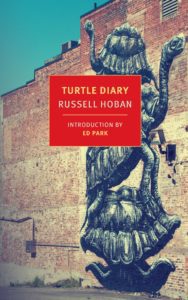
The tempting line of thinking for lonely people is that if only there were somebody who’d understand, we could somehow be less alone. But there’s the fear that this person does not exist—along with innumerable other fears—and thinking only makes matters worse. The trouble is that thoughts are individual. To have thoughts is to perpetuate solitude, to effectively maroon ourselves. Russell Hoban’s Turtle Diary is concerned with how it is possible to carry on, when there’s this problem of thinking. Whether this empathetic other person is real or imaginary—Hoban seems to say—is beside the point.
In Turtle Diary, two strangers predisposed to despair arrive separately at the idea of setting a zoo’s sea turtles free. William G. is a glum, divorced bookstore employee and Naera H. is a never-married author of children’s books who can’t, at the moment, do any writing. They’re reluctant soulmates, who narrate the novel in alternating diary entries. What happens, save for the turtle interlude, is primarily interior. William documents a trip to the London zoo: “Two of the turtles at the aquarium are green turtles, a large one and a small one. The sign said: ‘The Green Turtle, Chelonia mydas, is the source of turtle soup.’ I am the source of William G. soup if it comes to that. Everyone is the source of his or her kind of soup. In a town as big as London that’s a lot of soup walking around.” Naera complains about a salad: “If I were to say that today’s tomatoes were an index of the decline of Western man I should be thought a crank but nations do not, I think, ascend on such tomatoes.”
The novel is about sadness, obsession, and giant sea turtles, but mostly it’s about how to be okay. At first it seems inevitable: find each other, kidnap captive turtles and set them free, live happily ever after. Where another story might revolve around lonesome, likeminded people, each coming to the other’s rescue, Turtle Diary doesn’t, for the fact that it isn’t true. Everything that’s wrong can’t magically be made right by finding that perfectly perceptive other person; the space that separates you from me will forever “stay quietly between us.” Rather than go the pleasant, regular way, Hoban opts to tell it straight: letting us down by saying, Sorry, no, but it’s just not that simple.
Though William and Naera both cherish the privacy of their own thoughts, they’re just as guilty of wanting to be wrong—hoping that coming together to liberate turtles will initiate some change in them. But after the turtlenap and release, a postpartum funk overcomes them both. In the awkward morning-after, William thinks, “Sometimes I’ve felt that way after sleeping with the wrong person, and the intimacy of sex is nothing compared to the intimacy of driving two hundred and fifty miles at night and putting turtles into the sea.” Later he says, “Launching the turtles didn’t launch me.”
He’s wrong, though. By the end, it’s clear that launching the turtles has launched him—and Naera, too—albeit quietly, without any fanfare. By the end, it’s a good thing that the turtles are in the sea, “swimming,” and the same goes for the novel’s characters. If there’s a lesson in the turtle-launch, it’s that the best course of action is to keep swimming, and to go on living. When Naera asks George Fairbanks, the zoo’s head keeper, how he manages to stay so cheerful, George says, “I don’t mind being alive.”
As much as Turtle Diary is about staving off despair (a real challenge because, as Naera puts it, “My despair has long since been ground up fine and is no more than the daily salt and pepper of my life.”), it’s also about moments of joy amidst the gloom, reflected—most immediately—in Hoban’s prose. The writing is buoyant and relentlessly delightful: precise, wry, poetic, tragic, and funny, all at once. What George and Naera realize—and us along with them—is that life, disappointing as it can be, can surprise us, too. “Something might happen,” is how both of them put it. It’s reason enough to make like turtles, and go on swimming.




